Cabinet Hardware Placement & Sizing Guide (US Standard): Knobs, Pulls, Handles and Hinges Explained

Have you ever stood in front of a set of cabinets and wondered, “Which knob should I pick, and where will this exactly go?” Well, we have all been there. While the size and placement of cabinet hardware might seem small, they play a major role in your space’s aesthetics and functionality.
Choosing the right hardware is crucial for not just how your space looks & feels. Well-sized, well-placed hardware components help prevent damage, keep doors and drawers running smoothly, and add a sense of order to the whole room. From home remodels to commercial projects, these small details can make a significant impact.
Getting these basics right avoids a lot of hassle down the line and ensures your cabinets look like a pro put them together. If you’re looking for the right fit or style, our Cabinet Hardware and Cabinet Accessories categories make it easy to find what you need.
Read further to know more about the standard placement & sizing of cabinet hardware.
But First, Let’s Understand the Different Types of Hardware
When choosing cabinet hardware, it helps to understand the basic categories before worrying about finishes or styles. In most kitchen or commercial cabinet layouts, hardware falls into four core types: pulls, knobs, handles, and hinges. Each plays a different role in how the cabinets function and look.
Below is a direct breakdown of these hardware types and how they are used.
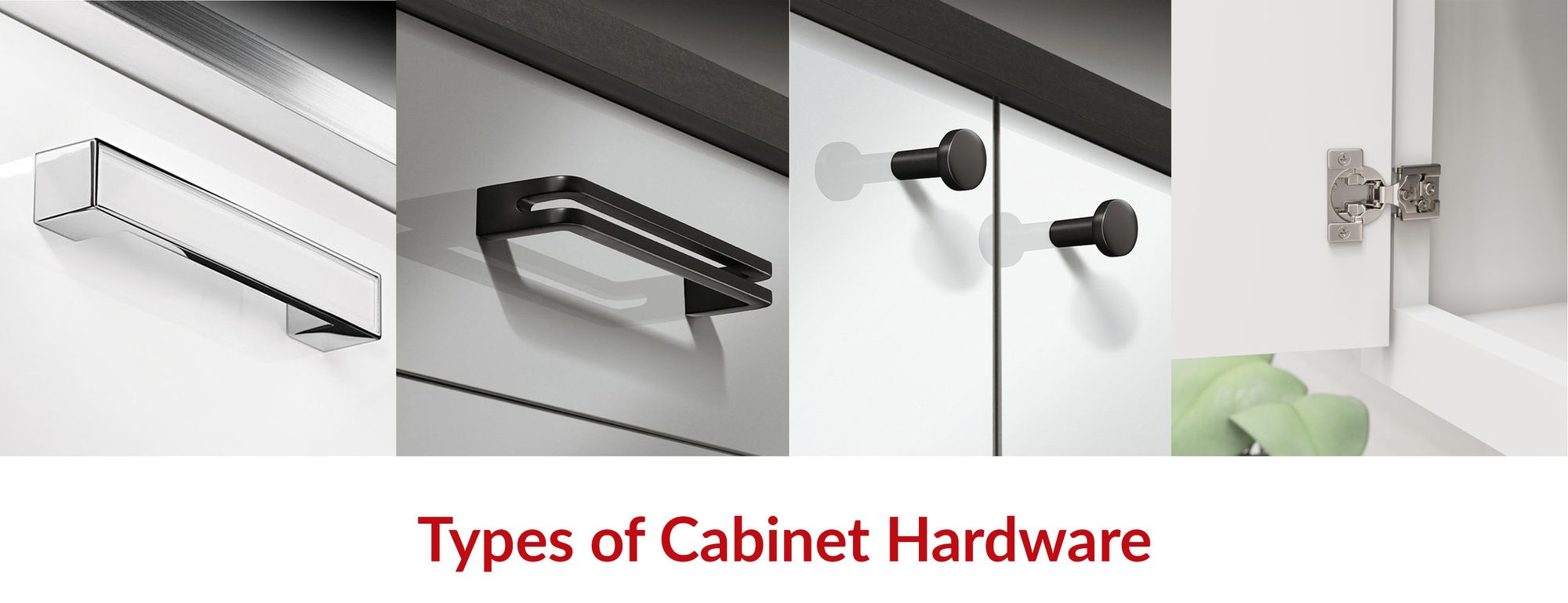
Cabinet Pulls
Pulls are mounted with two screws and offer a firm grip. They’re most commonly used on drawers but are also an excellent option for tall cabinet doors or anywhere that extra leverage is needed. Pulls come in dozens of styles and lengths, from small 3-inch models to appliance-size pulls.
When Should You Use a Cabinet Pull?
- Best for drawers of any size
- Suitable for full-height pantry doors
- Preferred in high-use spaces like kitchens, offices, and hospitality areas
Cabinet Knobs
Knobs are attached with a single screw and are typically used on cabinet doors or smaller drawers. They’re easier to install and are often used in traditional layouts. Despite their simplicity, they come in a wide range of shapes, finishes, and profiles.
When Should You Use Cabinet Knobs?
- Ideal for upper cabinet doors
- Standard in vanities and smaller drawers
- Popular in traditional and transitional kitchens
Cabinet Handles
Handles generally refer to more extended grips, which are sometimes categorized as pulls but can also include appliance pulls and other specialized formats. They’re suited for heavy drawers or doors where a secure grasp is needed.
When Should You Use Cabinet Handles?
- Used on wide drawers or heavy cabinet doors
- Works well in contemporary kitchens and commercial cabinetry
- Recommended for ADA or senior-accessible designs when paired with proper clearances
Cabinet Hinges
Hinges attach doors to cabinet frames and determine how the door swings open and closes. You’ll typically see concealed (European-style) hinges in modern builds and exposed decorative hinges in traditional designs. The right hinge will also depend on the door overlay and cabinet construction type.
Where are Cabinet Hinges used?
- Concealed hinges for a clean, minimal look
- Decorative hinges for inset or face-frame cabinets
- Soft-close options are available for high-end applications
Knob Size & Placement Guide for Cabinets and Drawers
When selecting cabinet knobs, the two main factors to get right are size and placement. A knob that's too small can feel flimsy, while one that's too large may look disproportionate. Placement matters just as much - wrong positioning can throw off the visual balance or make a cabinet awkward to use.
Let’s take a look at standard US sizing, recommended placement for cabinet doors and drawers, and when to consider alternatives.
Standard US Knob Sizes
Most cabinet knobs fall between 1 inch and 1.5 inches in diameter. The right size depends on the width of the door or drawer and the overall design style.
General Cabinet Knob Size Guidelines:
- 1" to 1-1/4": Best for doors and narrow drawers under 12" wide
- 1-1/4" to 1-3/8": Good all-purpose size for most kitchen cabinets
- 1-1/2" and above: Works for large drawers, pantry doors, or furniture-style cabinets
Knob Size by Cabinet/Drawer Width:
The Standard Knob Placement on Cabinet Doors
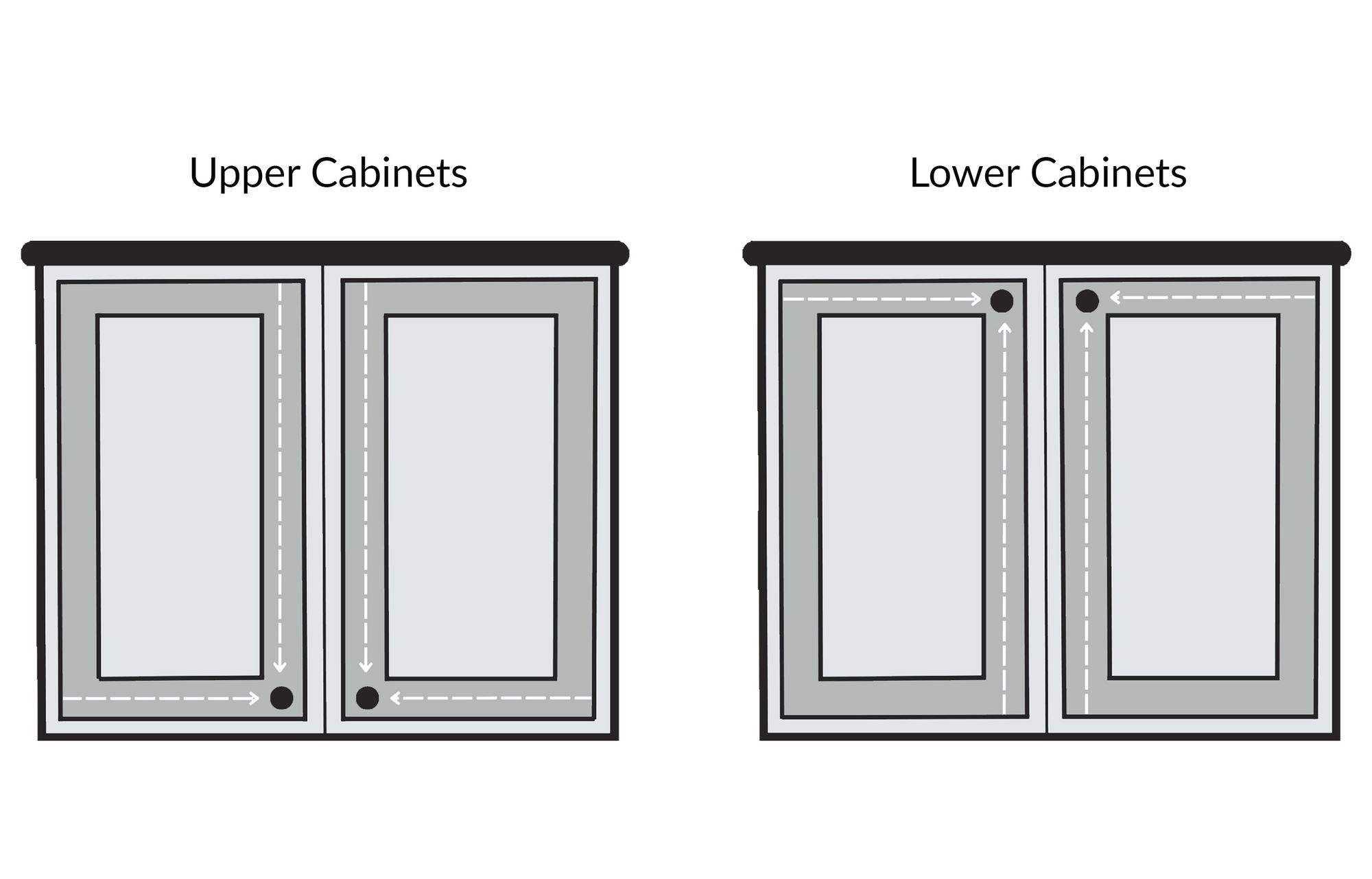
Knob placement on cabinet doors depends on both cabinet construction and design.
Frame vs. Frameless Cabinets:
- Framed Cabinets: Place the knob 2.5" to 3" from the bottom corner of the upper door (or top corner of lower door), and 1"–1.5" in from the edge of the frame.
- Frameless Cabinets: Use similar measurements but adjust visually since there’s no face frame for alignment.
Design Alignment:
- Traditional: Knobs are typically placed close to the corner of the stile and rail.
- Transitional: Slightly more flexibility — centered vertically on the stile is common.
- Modern/Minimalist: This type can be placed higher or lower depending on clean-line priorities; it is often aligned horizontally across a cabinet bank.
Knob Placement on Drawers
Drawer knob placement is all about symmetry and function. Placement may vary slightly depending on the drawer height and width.
Standard Recommendations:
- For drawers under 24" wide, place a single knob centered horizontally and vertically.
- For drawers 24" to 36" wide, you can use either one large knob centered or two smaller knobs spaced evenly.
- For drawers taller than 8", center the knob vertically; for shallow drawers, position slightly above center for a more ergonomic grip.
One vs. Two Knobs: How Many Knobs To Use For Your Drawer?
- Use two knobs on wide drawers (over 30") to reduce stress on the drawer face and provide a balanced grip.
- Always measure and drill using a jig or template to ensure consistency across drawers.
Quick Reference – Knob Quantity by Drawer Width:
This sizing and placement strategy ensures your hardware looks intentional and feels comfortable to use. For drawer banks or multi-unit installs, consistency is key - use a template or drilling jig to maintain alignment.
Pull Size & Placement Guide for Cabinets and Drawers
Pulls are often the preferred hardware for drawers and large doors, offering better grip and leverage than knobs. Getting the size and placement right is essential for both appearance and usability. A pull that’s too short can look lost on a wide drawer, while one that’s too long may overpower the cabinet face.
As you read further, we discuss how to select the right pull length and install it in the correct position based on cabinet type and drawer size.
Cabinet Pull Sizes & Sizing Chart
Cabinet pulls are typically measured by their center-to-center (C-C) distance, i.e., the space between the screw holes, not the overall length. Standard pull lengths range from 3 inches to 12 inches, with longer pulls available for oversized cabinets.
A common rule of thumb is to choose a pull that’s roughly one-third the width of the drawer front. This maintains balance and prevents the hardware from feeling too small or oversized.
Center-to-Center (C-C) and Overall Length Reference:
Recommended Pull Size by Drawer Width:
Cabinet Pull Placement on Cabinet Doors
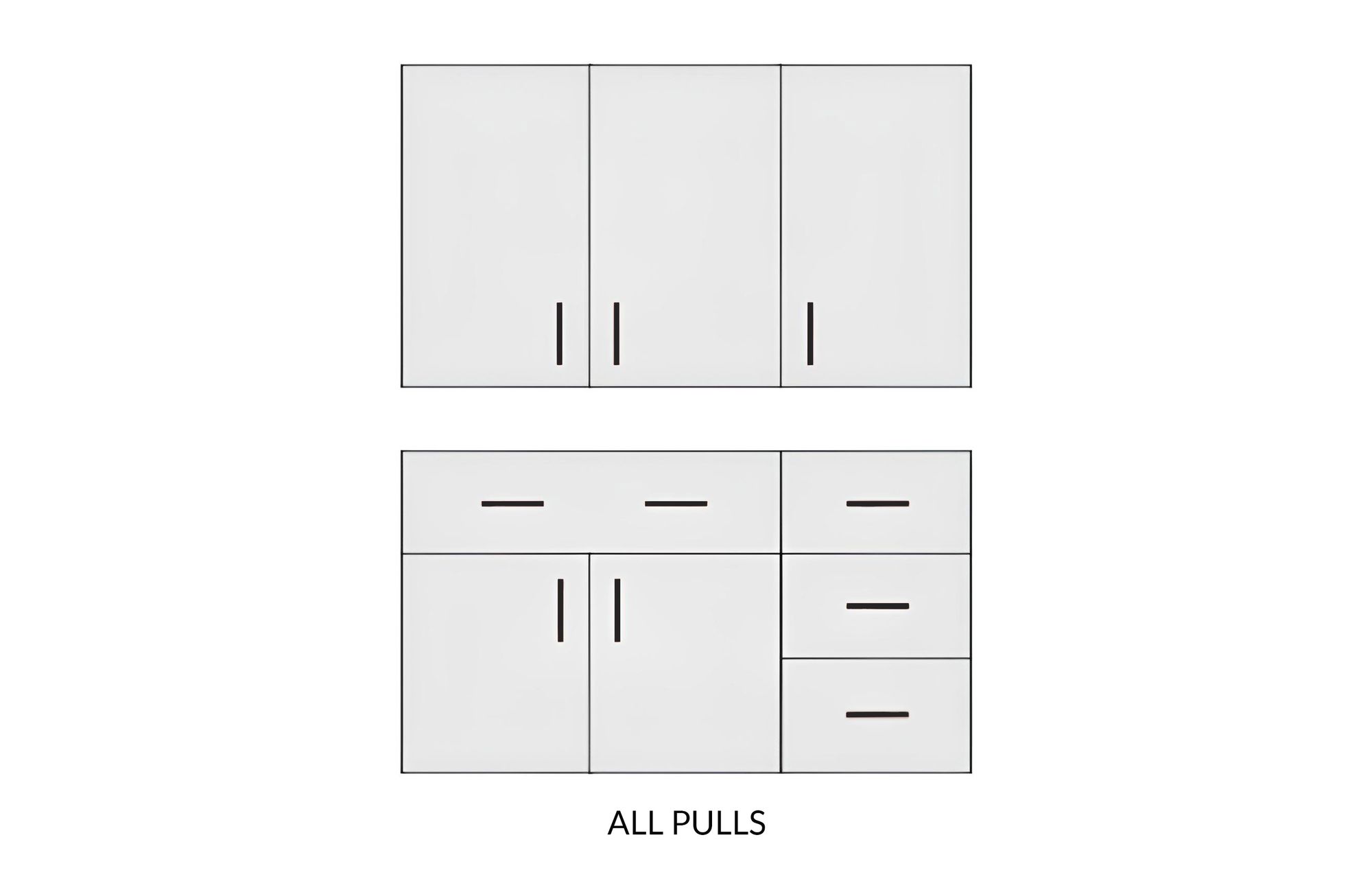
Pulls on cabinet doors are typically mounted vertically, about 2.5" to 3" up from the bottom (for upper doors) or down from the top (for base doors), and 1" to 1.5" in from the edge of the door.
Frame vs. Frameless Cabinets:
- Framed Cabinets: Measure from the inside edge of the frame stile.
- Frameless Cabinets: Use the outer edge of the door as a reference, adjusting for visual alignment.
Based Door Design:
- Slab Doors: More flexibility in placement - many modern kitchens align pulls horizontally across all upper and lower cabinets for a streamlined look.
- Paneled or Shaker Doors: Align pulls with the rail or stile for a clean, structured appearance.
Pull Placement on Drawers
For drawers, pulls are almost always mounted horizontally, centered on the drawer front. However, their placement can vary slightly depending on the drawer's height and depth of use.
Best Practices for Placing Pulls on Drawers:
- Standard Placement: Centered horizontally and vertically.
- Shallow Drawers (under 6"): Consider placing pulls slightly above center for easier grip.
- Deep Drawers (8"+): Center placement or slightly above center if user comfort is a concern.
When to Use One vs. Two Pulls:
- Use a single pull for drawers up to 30" wide.
- Use two pulls for drawers wider than 30" to prevent twisting and ensure balanced opening.
Handle Size & Placement Guide For Cabinets & Drawers
Cabinet handles, sometimes called long pulls or appliance pulls, are used where grip strength, symmetry, or a more pronounced design element is needed. While they overlap with pulls in function, handles are typically longer and more prominent, often used on large drawers, tall pantry doors, or integrated appliance panels.
Selecting the right size and position matters not only for aesthetics but also for ease of use, especially in commercial environments or ADA-compliant installations.
Cabinet Handle Sizes Guide
Handles are measured from center to center (C-C) like standard pulls. Depending on the application, common sizes range from 5 inches to over 24 inches.
Standard Handle Lengths & Ideal Uses:
Appliance handles typically start at 12" and are secured with rear mounting bolts for structural stability.
Placement Guidelines for Handles:
On Cabinet Doors
Mount vertically, 2.5" to 3" from the top or bottom corner, and 1" to 1.5" in from the door edge. For tall pantry doors, handles may be mounted centrally along the vertical axis or spaced to match surrounding cabinet hardware.
On Drawers
Handles should be centered horizontally. For drawers taller than 10", place them in the upper third for better ergonomics.
On Appliance Panels
Always follow the appliance manufacturer’s panel kit or handle guidelines. These pulls are weight-bearing and must be bolted securely.
When to Use Handles Instead of Pulls:
- You want a consistent, modern look with long horizontal lines. Drawers or doors are extra wide or tall
- You're designing for accessibility and need more surface to grip
In commercial or multi-unit settings, handles should be consistent in size across doors/drawers of the same width for a clean, intentional appearance. Use a template to standardize height and spacing.
What are the Different Hinge Types & their Ideal Placement?
Hinges are the functional core of any cabinet door system, but their placement and type can also impact aesthetics, durability, and usability. Whether you’re working on a modern frameless kitchen or a traditional face-frame setup, understanding hinge styles and placement rules ensures clean movement, proper alignment, and long-term performance.
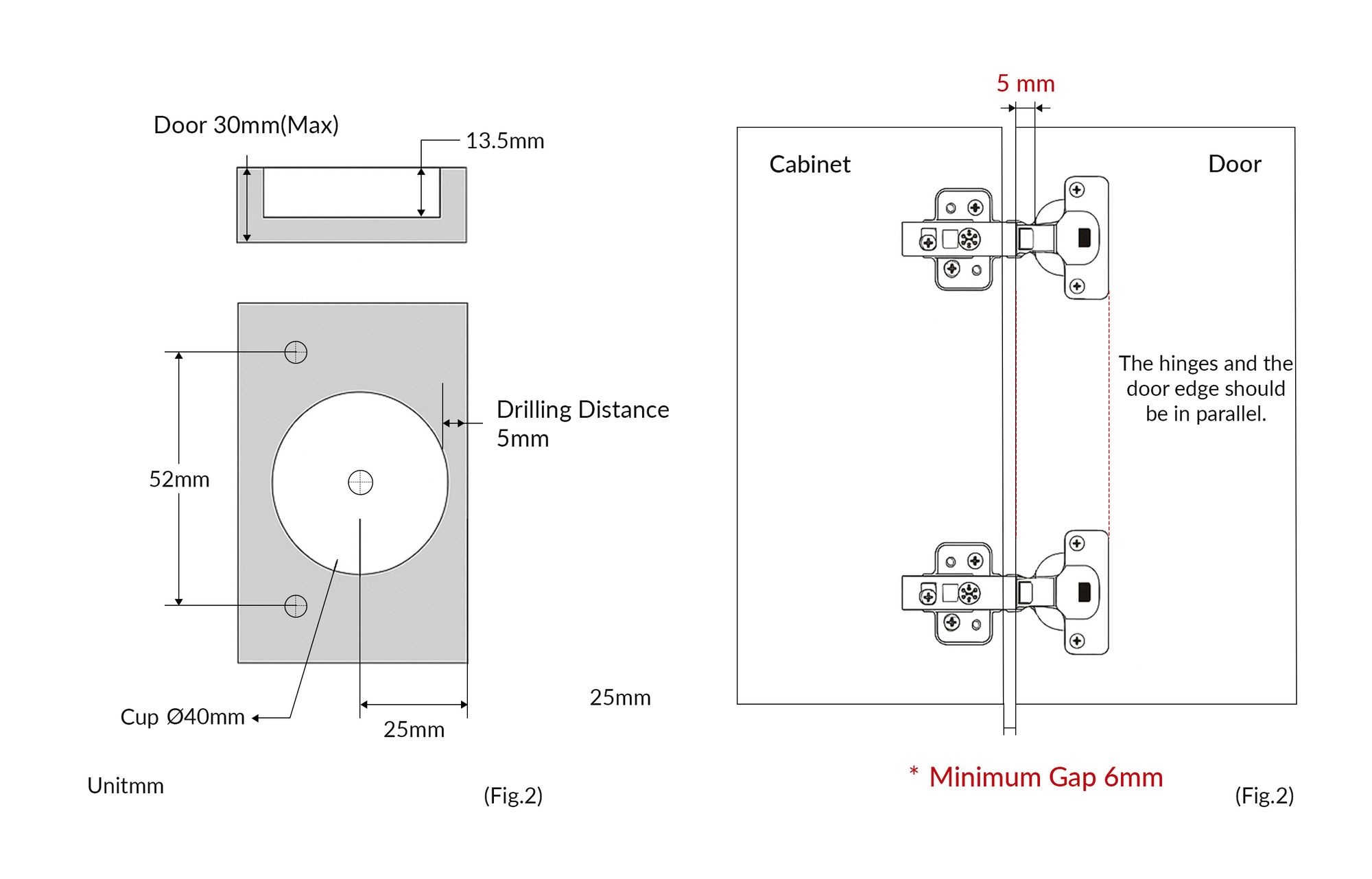
Euro Hinges vs. Surface-Mounted Hinges
European (Concealed) Hinges
- Hidden from view when the door is closed
- Installed with a 35mm cup bore in the back of the door
- Allow full overlay, partial overlay, or inset configurations
- Offer easy adjustability after installation
Surface-Mounted (Exposed) Hinges
- Visible from the front when the door is closed
- Common in face-frame and inset cabinets
- No cup boring required - mounted directly to the frame and door
- Available in decorative styles and finishes
Hinge Quantity by Door Height
The number of hinges you use should be based on door height and weight. A lightweight 24" door doesn't require the same reinforcement as a 40" pantry door.
Recommended Hinge Count:
Hinge Placement Guidelines
- Top Hinge: Positioned 2" to 2.5" from the top of the door
- Bottom Hinge: Positioned 2" to 4" from the bottom
- Third Hinge (if used): Centered between top and bottom hinges
- Fourth Hinge: Space evenly or bias the extra support where weight is highest (often the top half)
Hinge Placement in Framed vs. Frameless Cabinets:
- Framed Cabinets: Hinges mount to the frame - alignment must account for stile position and door overlay
- Frameless Cabinets: Hinges mount directly to the side panel (carcass), often with full overlay settings
Always check hinge overlay specs before drilling. Using the wrong cup depth or overlay angle can affect how the door swings and closes. To learn more about the size of the hinge you want to use, check out our hinge size guide today!
Specialty Cabinet Hardware Placement & Sizing
While most hardware placement follows general best practices, some applications require a more tailored approach. Whether you're upgrading a modern slab kitchen, restoring a traditional built-in, or specifying ADA-compliant millwork, details like alignment, hardware type, and mounting height become more nuanced.
Design-Specific Cabinet Hardware Placement
Different cabinet designs call for different hardware strategies, both visually and functionally.
Shaker Cabinets
- Knobs and pulls are typically aligned with the stile (vertical rail) for visual balance.
- For drawers, pulls are centered or aligned with the top rail, depending on drawer depth.
- Works best with simple round knobs or classic bar pulls.
Modern / Slab Cabinets
- Clean lines mean edge pulls, tab pulls, or long bar pulls are common
- Hardware is often placed in consistent horizontal lines across all uppers and lowers
- Minimalist look: fewer visual interruptions, centered alignment often skipped for visual flow
Traditional Cabinets
- Hardware is part of the aesthetic; ornate knobs, cup pulls, and decorative hinges are common.
- Knobs are often centered on doors, while pulls on drawers may follow a top-third rule.
- Symmetry matters more than strict alignment rules.
Application-Specific Cabinet Hardware Placement
Not all cabinets are created equal. Tall pantry doors, vanities, or extra-wide drawers may require size or placement adjustments.
Tall Pantry Doors
- Use long appliance pulls (12"–18") for proportion
- Place vertically, centered, or slightly higher for ergonomic reach
- For double-door pantries, ensure mirrored alignment
Base Drawers (Wide or Deep)
- For drawers over 30", use either a long pull or two shorter pulls spaced evenly.
- Pulls are typically placed in the top third of the drawer face for better leverage.
Vanity Cabinets
- Smaller profiles work best (1"–1.25" knobs or 3"–4" pulls)
- Placement should account for nearby sinks or backsplash clearances
- Use materials that can withstand moisture exposure in bathrooms
Consider the durability of the hardware finish (e.g., matte black, brushed nickel, stainless steel) in high-touch or humid environments.
ADA-Compliant Cabinet Hardware
Cabinet hardware in accessible environments must meet ADA reach range and operability requirements. This is especially important in healthcare, senior living, and public facility projects.
Reach Range Guidelines:
- 15" to 48" from the floor is the accepted accessible zone
- Avoid mounting hardware above counters or obstacles that restrict reach
Hardware Shape & Function:
- Must be operable with one hand and not require tight grasping or twisting
- D-shaped pulls, bar pulls, and loop-style handles are preferred
- Avoid small knobs or recessed finger pulls
Installation Tips:
- On base cabinets, install pulls no lower than 15" from the floor
- On uppers, ensure they’re not mounted higher than 48" from the finished floor
- Consider horizontal pulls on drawers and vertical handles on doors for intuitive use
Cabinet Hardware Installation - Best Practices & Common Mistakes
Even the proper hardware can feel wrong if it's installed poorly. Crooked alignment, split cabinet faces, or mis drilled holes aren’t just frustrating—they can be expensive to fix, especially on large projects. Whether you're outfitting a residential kitchen or a commercial space, following standard installation practices ensures clean results and long-term durability.
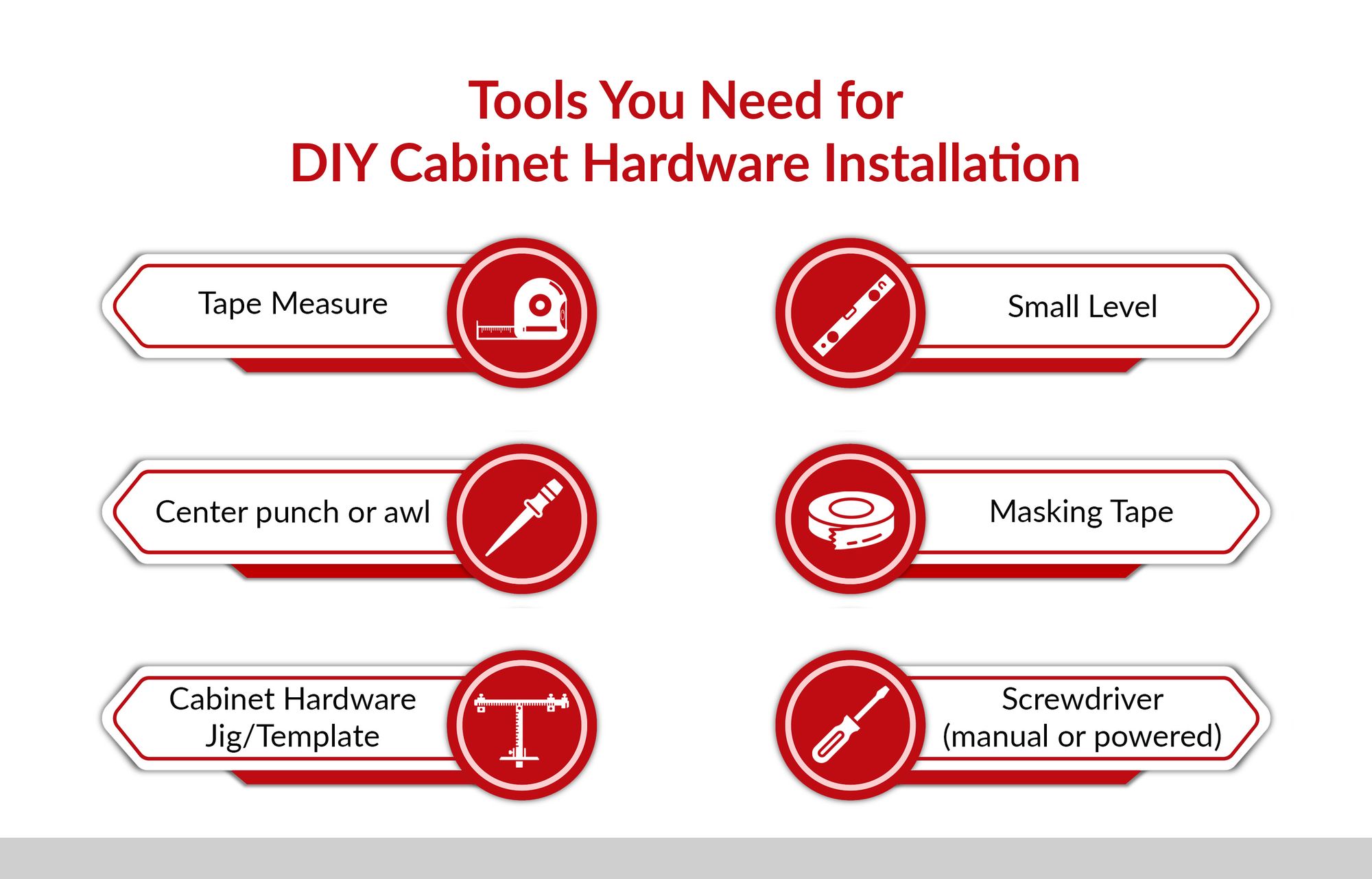
Drill Bits, Pilot Holes & Screw Sizes For Cabinet Hardware
Different hardware requires different screw lengths and drill sizes. Most cabinet hardware comes with 8-32 machine screws, but drawer thickness and backplate style can affect fit.
Common Drill Bit & Screw Guidelines:
Always drill straight through using steady pressure. Backer boards or clamps help prevent blowout on the back side of the panel. Our screw size guide will help you in detail!
Visual Alignment Across Cabinet Runs
The most common visual mistake is hardware that’s technically centered but looks misaligned when compared across multiple cabinets. Inconsistent spacing between drawers or from frame edges can ruin a clean layout.
Tips to Avoid Misalignment:
- Mark centerlines across all drawers before installing anything.
- For stacked drawers, keep pulls at the same vertical height for visual rhythm.
- Use a cabinet hardware jig to lock in consistent offsets from edges.
- Don’t rely on pre-marked holes unless they're adjustable for your layout.
Always install a complete hardware set on one upper and one lower cabinet first. Stand back and assess the visual flow before drilling everything else.
Common Mistakes to Avoid While Installing Cabinet Hardware
- Skipping pilot holes - leads to wood splits and misalignment.
- Using mismatched screws - Can result in loose hardware or stripped threads.
- Measuring only once – Double-check all dimensions, especially on mirrored cabinets.
- Not adjusting for overlays – Face-frame vs. frameless cabinets require different placement logic.
- Assuming all drawers are equal – Sizes vary, even in the same cabinet run.
When hardware installation is done right, it saves time, prevents callbacks, and ensures that the finished cabinets look and feel as good as they function.
Start Shopping Cabinet Hardware at DK Hardware
Now that you have the placement standards and sizing rules in hand, sourcing the proper hardware is the next step. At DK Hardware, you'll find a full range of cabinet knobs, pulls, handles, and hinges - available in multiple styles, sizes, and finishes to match every interior design.
We carry industry-trusted brands and hardware that meet residential, hospitality, and ADA compliance needs. From classic round knobs to long appliance pulls and soft-close European hinges, every product is backed by detailed specs and fast nationwide shipping.
Are you a contractor, builder, or designer? Request a quote today & get access to volume pricing, tailored support, and fast-track ordering.
Furthermore, follow us on Instagram, Pinterest, Facebook, and YouTube for instant industry updates, and keep an eye on this space for more such detailed blogs and guides.
